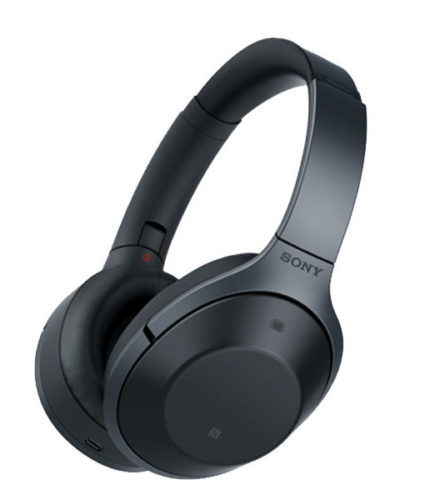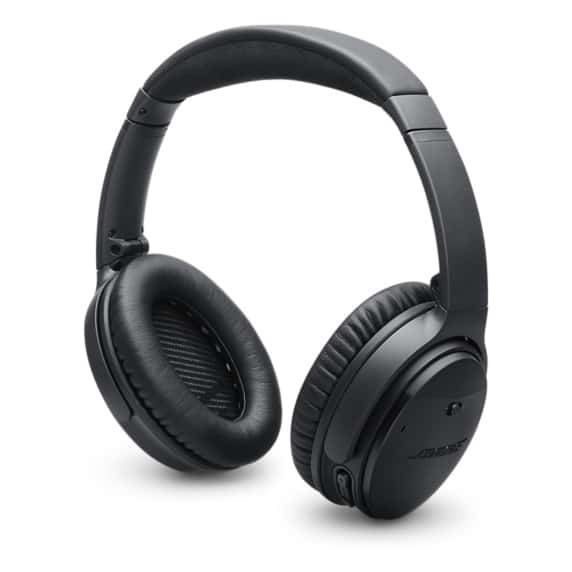In recent years, the name Bose has become synonymous with active noise cancellation. The QuietComfort series possessed nearly unparalleled quality in noise cancellation technology. However, a new contender has emerged boasting superior ANC and other features. Many have asked, and we decided it’s time to answer – which wireless, noise-cancelling headphone is better Sony MDR-1000X vs Bose QuietComfort 35?
Sony MDR-1000X vs Bose QuietComfort 35 Review
Sony MDR-1000X vs Bose QuietComfort 35 – Packaging
Both headphones are shipped in hard-grade carry cases that lay flat and have a pocket to hold their detachable cables and/or airline adapters. Both cases are rectangular with rounded corners. They feature a thin layer of leather on the outside and fabric on the inside. The shape of both cases make it easy to slip them into the side of a suitcase or large rectangular purse.
Sony MDR-1000X vs Bose QuietComfort 35 – Build & Design
Side-by-side, the MDR-1000X reveals a more premium looking build than that of the QC 35. It’s primarily covered in a thin layer of synthetic leather while the QC 35 is primarily covered in plastic. Both headphones are durable, but the Sony is all the more luxe. The extenders are an exposed slider that is a dark color and comprised of a sort of plastic or metal material. I think the QC 35, however, takes the lead when it comes to padding because the cushions feel a tiny bit fluffier around the ear – almost like pillows. The seal feels solid. On the other hand, Sony features soft leather cushions, but they are a little shallow. I’d prefer a bit more padding. Also, the headband is only padded on the top portion where your noggin hits the band. In addition, the frame is a bit heavier. If you’ve got a small head, the bottom of the ear cups place a bit of pressure on the jaw. It’s not a deal breaker, but something to be considered if you plan to wear these headphones for extended periods of time.
Sony MDR-1000X vs Bose QuietComfort 35 – Sound
When it comes to sound quality, both of the headphones do their share in providing clear and full, rich audio. Though, there are subtle differences that set the headphones apart. The MDR-1000X offers a well-rounded sound signature with warmth and a little oomph in the bass. Not an excessive amount, but just enough to illicit a nice toe-tapping bass line. It’s all very relaxed and an overall pleasant listening experience. Bose QuietComfort 35 offers more of a driving bass line. It’s by no means terrible, but it comes off at times a bit aggressive. So, the overall tone of your music is not as relaxed, but just as warm.

Sony MDR-1000X vs Bose QuietComfort 35 – Features
The primary function of both headphones is to provide ANC over wireless connectivity. The QC 35 is able to provide ANC for up to 20 hours and when you run out of battery a quick charge of 15 minutes yields up to 2.5 hours of go time. The MDR-1000X will get you just about the same, 20 hours of use.
Sony has a competitive edge over Bose when it comes to your noise cancellation experience. The MDR-1000X is able to do so in two ways. Hitting the “Ambient Sound” button adjusts the level of active noise cancellation between maximum, a level optimized for voices, and a level optimized for noise. These headphones also personalize the ANC experience based on your physiological preferences/characteristics (like wearing glasses) then further and tailors the ANC to suit. You do so by pressing the “NC” button initiates a hearing test, which measures the degree of ANC best for you and your environment. Lastly, you can seamlessly engage in conversation by placing your hand over the right ear cup. This instantly muffles your music. This talk-through feature is revolutionary for a wireless ANC headset. Bose, unfortunately, doesn’t allow for any of this customization. While Bose is a commuter headphone, Sony’s features better accommodate the stresses of a frequent traveler.
Sony MDR-1000X vs Bose QuietComfort 35 – Noise-Cancelling
Both headphones provide a supreme level of ANC. For the longest time, Bose was the leader in ANC. Their technology worked by simply turning on the headphone which automatically turns on active noise cancellation. The amount of ANC provided by the QC 35 is more than enough to mute your co-workers, the radio, air conditioner hums, and the like. But, despite their strength and reputable career in ANC, I’d say it’s time for Bose to pass the torch. Sony MDR-1000X is just as strong in ANC ability, if not a bit stronger. Their ANC is not for the faint of ears. If ANC makes you feel the slightest bit like you’re about to get motion sickness, ANC at full capacity on the MDR-1000X might just do it to you. There’s also the addition of all those cool user-friendly customizations and seamless talk-through technology that the QC 35 does not have.
Sony MDR-1000X vs Bose QuietComfort 35 – Be Advised
Okay, so we couldn’t leave you all without acknowledging a few issues (technical and legal) associated with Bose. The company’s latest firmware update has been known to render some headsets utterly useless as the noise cancellation no longer works. This problem is still under review. As for legal issues, Bose currently faces two lawsuits. The first involving the sale of customer information without consent and the second for allegedly stealing technology from a headphone start-up. We have yet to hear of any issues plaguing Sony headsets, but if there were we will be sure to mention them here.
Issues aside, both headphones are great at performing their basic functions – wireless connectivity and active noise cancellation. However, in my humble opinion the Sony MDR-1000X takes the lead, as it is loaded with the necessary features that take this headphone from a mere noise-cancelling headset to a fully, customizable experience.
Sony MDR-1000X is available at Audio 46 Sony Shop and Amazon for the low price of $399.99.
Bose QuietComfort 35 retails at $349.99 on Amazon.
MAJORHIFI may receive commissions from retail offers.








